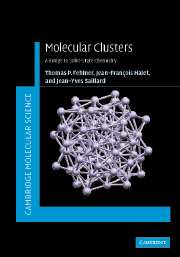Book contents
- Frontmatter
- Contents
- Preface
- 1 Introduction
- 2 Main-group clusters: geometric and electronic structure
- 3 Transition-metal clusters: geometric and electronic structure
- 4 Isolobal relationships between main-group and transition-metal fragments. Connections to organometallic chemistry
- 5 Main-group–transition-metal clusters
- 6 Transition to the solid state
- 7 From molecules to extended solids
- 8 Inter-conversion of clusters and solid-state materials
- Appendix: Fundamental concepts: a concise review
- Problem Answers
- References
- Index
- References
3 - Transition-metal clusters: geometric and electronic structure
Published online by Cambridge University Press: 19 February 2010
- Frontmatter
- Contents
- Preface
- 1 Introduction
- 2 Main-group clusters: geometric and electronic structure
- 3 Transition-metal clusters: geometric and electronic structure
- 4 Isolobal relationships between main-group and transition-metal fragments. Connections to organometallic chemistry
- 5 Main-group–transition-metal clusters
- 6 Transition to the solid state
- 7 From molecules to extended solids
- 8 Inter-conversion of clusters and solid-state materials
- Appendix: Fundamental concepts: a concise review
- Problem Answers
- References
- Index
- References
Summary
To a large extent, we expect the cluster bonding principles established for main-group clusters in Chapter 2 to carry over to transition-metal clusters. However, the AO basis sets for building MOs differ for transition metals which means that the expression of the cluster bonding principles in geometric and electronic structure will also differ. That is, the observed cluster compositions and shapes differ and these differences can be associated with the participation of the metal d functions in cluster bonding. The d functions are the “wild cards” that make transition-metal chemistry so interestingly different from main-group chemistry. In writing Chapter 3 we have assumed that the reader has a basic understanding of the principles of cluster bonding as expressed by p-block clusters (Chapter 2). Emphasis here is placed on the varied expression of d-block metal character within a cluster context. A number of monographs on metal clusters are suggested at the end of this chapter as additional reading for those interested in pursuing a topic in more depth.
Three-connect clusters
Main-group clusters that exhibit three-connect shapes can often be described using localized two-center bonds. What is the situation for metal clusters?
Localized two-center bonds
Two-center–two-electron bonding and the eight-electron rule adequately rationalize three-connect clusters like P4; hence, we expect the 18-electron rule to suffice for three-connect transition-metal clusters like tetrahedral Ir4(CO)12 (Figure 3.1) with 12 terminal carbonyl ligands. Indeed it does.
- Type
- Chapter
- Information
- Molecular ClustersA Bridge to Solid-State Chemistry, pp. 85 - 138Publisher: Cambridge University PressPrint publication year: 2007



